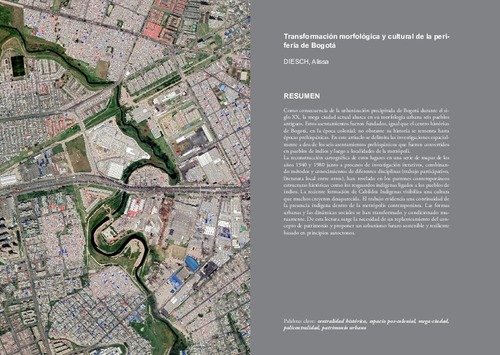Transformación morfológica y cultural de la perifería de Bogotá

Visualitza/Obre
Cita com:
hdl:2117/361079
Tipus de documentArticle
Data publicació2021-12
EditorGrup de Recerca en Urbanisme. Departament d'Urbanisme i Ordenació del Territori. Universitat Politècnica de Catalunya
Condicions d'accésAccés obert
Llevat que s'hi indiqui el contrari, els
continguts d'aquesta obra estan subjectes a la llicència de Creative Commons
:
Reconeixement-NoComercial-SenseObraDerivada 3.0 Espanya
Abstract
Como consecuencia de la urbanización precipitada de Bogotá durante el siglo
XX, la mega ciudad actual abarca en su morfología urbana seis pueblos
antiguos. Estos asentamientos fueron fundados, igual que el centro histórico
de Bogotá, en la época colonial; no obstante su historia se remonta hasta
épocas prehispánicas. En este artiuclo se delimita las investigaciones espacialmente
a dos de los seis asentamientos prehispánicos que fueron convertidos
en pueblos de indios y luego a localidades de la metrópoli.
La reconstrucción cartográfica de estos lugares en una serie de mapas de los
años 1940 y 1980 junto a procesos de investigación iterativos, combinando
métodos y conocimientos de diferentes disciplinas (trabajo participativo,
literatura local entre otros), han revelado en los patrones contemporáneos
estructuras históricas como los resguardos indígenas ligados a los pueblos de
indios. La reciente formación de Cabildos Indígenas visibiliza una cultura
que muchos creyeron desaparecida. El trabajo evidencia una continuidad de
la presencia indigena dentro de la metrópolis contemporánea. Las formas
urbanas y las dinámicas sociales se han transformado y condicionado mutuamente.
De esta lectura surge la necesidad de un replanteamiento del concepto
de patrimonio y proponer un urbanismo futuro sostenible y resiliente
basado en principios autoctonos. As a consequence of the rapid urbanization of Bogotá during the 20th century, the current mega city includes six ancient villages in its urban morphology. These settlements were founded, like the historical center of Bogota, in colonial times, but their history dates back to pre-Hispanic times. In this article, research is spatially delimited to two of the six pre-Hispanic settlements that were converted into Indian villages and later to districts of the metropolis. The cartographic reconstruction of these places in a series of maps from the 1940s and 1980s together with iterative research processes, combining methods and knowledge from different disciplines (participatory work, local literature among others), have revealed in the contemporary patterns historical structures such as the indigenous resguardos linked to the Indian villages. The recent formation of indigenous councils has made visible a culture that many believed it would have been disappeared. The work evidences a continuity of indigenous presence within the contemporary metropolis. Urban forms and social dynamics have transformed and conditioned each other. From this reading arises the need to rethink the concept of heritage and propose a sustainable and resilient future urbanism based on autochthonous principles.
Localització
CitacióDiesch, A. Transformación morfológica y cultural de la perifería de Bogotá. "QRU: Quaderns de Recerca en Urbanisme", Desembre 2021, núm. 12, p. 78-96.
ISSN2385-6777
Col·leccions
| Fitxers | Descripció | Mida | Format | Visualitza |
|---|---|---|---|---|
| QRU 12M 78-97 .pdf | 6,196Mb | Visualitza/Obre |


